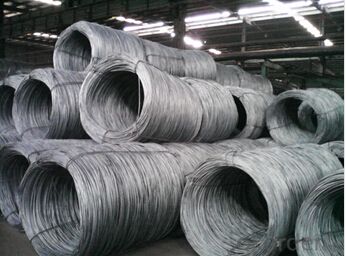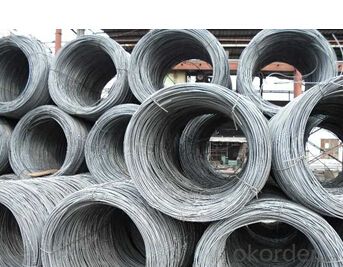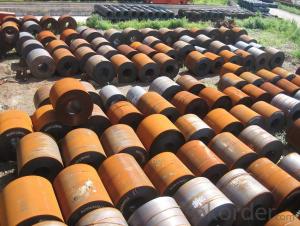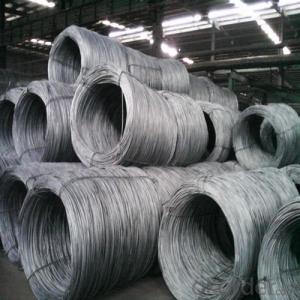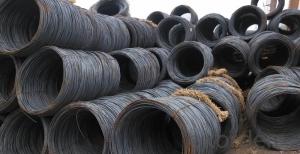Hot Rolled Wire Rod for Q195/235, SAE1006-1018B
- Loading Port:
- Tianjin
- Payment Terms:
- TT OR LC
- Min Order Qty:
- 500 m.t.
- Supply Capability:
- 10000 m.t./month
OKorder Service Pledge
OKorder Financial Service
You Might Also Like
1.Structure of Hot Rolled Wire Rod Description
After hot-rolled the products shaped into coil and delivery as finished product, including round, square, rectangular, hexagonal and so on. Since most of the products are round, it is generally called wire rod. Carbon steel wire rod is widely used in construction and manufacturing. Carbon steel wire rod is mainly used for reinforcement of reinforced concrete and welded structure or reprocessed (roberts , nail, etc.) materials, especially used to produce wire drawing, welding electrode, nails, spring, electronic, precise machinery parts and so on.
2.Main Features of the Aluminum Alloy Wheel Hub
high quanlity
easy to delivery
extensive use
3.Specifications of Hot Rolled Wire Rod
Steel Grade: Q195/235, SAE1006-1018B Standard: ASTM, GB
Diameter: 5.5mm, 6.5mm, 7mm,8mm,9mm,10mm,12mm,14mm
Type: in coil, coil weight around 2MT Alloy or Not: Alloy
Technique: Hot Rolled
Place of Origin: China Mainland
Surface: round, no twisted, light and smooth
Chemical Composition: (Please kindly find our chemistry of our material based on Q195、Q235A and Q235B as below for your information)
Trademark | Rank | Chemical composition (quality score) % | ||||||
C | Si | Mn | S | P | ||||
| ≤ |
| ≤ | ≤ | ||||
Q195 |
| 0.06-0.12 | 0.30 | 0.25 | 0.050 | 0.045 | ||
Q235 | A | 0.14-0.22 | 0.30 | 0.30-0.65 | 0.050 | 0.045 | ||
Q235 | B | 0.12-0.20 | 0.30 | 0.30-0.70 | 0.045 | 0.045 | ||
4.Packaging & Delivery of Hot Rolled Wire Rod
Packaging Detail: products are packed in coil, each coil weight around 2 MT, and then shipped by container or bulk vessel
Delivery Detail: within 45 days after received deposit or LC.
Label: to be specified by customer, generally, each bundle has 1-2 labels
Trade terms: FOB, CFR, CIF
5.FAQ
We have organized several common questions for our clients,may help you sincerely:
①How about your company?
A world class manufacturer & supplier of castings forging in carbon steel and alloy steel,is one of the large-scale professional investment casting production bases in China,consisting of both casting foundry forging and machining factory. Annually more than 8000 tons Precision casting and forging parts are exported to markets in Europe,America and Japan. OEM casting and forging service available according to customer’s requirements.
②How to guarantee the quality of the products?
We have established the international advanced quality management system,every link from raw material to final product we have strict quality test;We resolutely put an end to unqualified products flowing into the market. At the same time, we will provide necessary follow-up service assurance.
③How long can we receive the product after purchase?
In the purchase of product within three working days, We will arrange the factory delivery as soon as possible. The pecific time of receiving is related to the state and position of customers.Commonly 7 to 10 working days can be served.
- Q: What are the main distribution channels for steel wire rod?
- The main distribution channels for steel wire rod include manufacturers, wholesalers, retailers, and e-commerce platforms. Manufacturers play a crucial role as they produce steel wire rod in various grades and sizes. They have their distribution networks to directly supply the product to wholesalers or retailers. These manufacturers often have their sales teams or agents who actively promote and sell their products to potential customers. Wholesalers are intermediaries who purchase large quantities of steel wire rod from manufacturers and then distribute it to retailers or other businesses. They typically have extensive networks and warehouses to store and transport the product efficiently. Wholesalers often offer competitive pricing and bulk discounts, making them an attractive option for retailers and businesses looking to buy steel wire rod in large quantities. Retailers are the final link in the distribution chain, selling steel wire rod directly to end consumers or small businesses. They can be specialized steel suppliers or hardware stores that carry a wide range of products. Retailers often provide convenient access to steel wire rod for customers who require smaller quantities or immediate availability. In recent years, the emergence of e-commerce platforms has significantly impacted the distribution of steel wire rod. Online marketplaces allow manufacturers, wholesalers, and retailers to reach a wider customer base and facilitate direct sales. E-commerce platforms provide convenience, quick delivery, and often offer competitive pricing, making it an increasingly popular choice for buyers. Overall, the main distribution channels for steel wire rod encompass a combination of traditional channels such as manufacturers, wholesalers, and retailers, as well as the growing prominence of e-commerce platforms in the industry.
- Q: What are the main uses of steel wire rod?
- Steel wire rod has a wide range of uses across various industries. It is primarily used for manufacturing wire products such as nails, screws, springs, and fencing. Additionally, it is used in the construction sector for reinforcing concrete structures and in the automotive industry for making tire cords and springs. Steel wire rod also finds application in the manufacturing of electrical cables, wire mesh, and welding electrodes.
- Q: How are steel wire rods used in the production of wire springs for various mechanical applications?
- Steel wire rods are used in the production of wire springs for various mechanical applications as they serve as the primary raw material. These rods undergo a series of manufacturing processes such as drawing, coiling, and heat treatment to transform them into wire springs. The wire rods provide the necessary strength, durability, and elasticity required for the springs to function effectively in applications such as automotive suspensions, industrial machinery, and furniture.
- Q: What are the main factors affecting the recyclability of steel wire rod?
- The main factors affecting the recyclability of steel wire rod include the quality and composition of the steel, the presence of contaminants or coatings on the wire, and the efficiency and effectiveness of the recycling process used.
- Q: How is steel wire rod used in the manufacturing of cables?
- Steel wire rod is used in the manufacturing of cables as it serves as the core material for strength and support. The steel wire rod is typically drawn through a series of dies to reduce its diameter and increase its strength, resulting in a high-tensile wire. This wire is then twisted or braided together with other wires or fibers to form the cable's core, providing durability and stability.
- Q: What are the main factors affecting the waste generation of steel wire rod production?
- The main factors affecting the waste generation of steel wire rod production include the quality and composition of raw materials used, the efficiency of production processes and equipment, the level of technological advancement, the skill and expertise of the workforce, and the implementation of waste management strategies and practices. Additionally, factors such as production volume, market demand, and regulatory requirements also play a role in waste generation.
- Q: What are the common quality control tests performed on steel wire rod?
- There are several common quality control tests performed on steel wire rod to ensure its compliance with the required specifications and standards. These tests are essential to guarantee the quality and integrity of the wire rod before it is further processed or used in various applications. Some of the common quality control tests performed on steel wire rod include: 1. Chemical Composition Analysis: This test determines the elemental composition of the steel wire rod, such as the percentage of carbon, manganese, phosphorus, sulfur, and other trace elements. It is crucial to ensure that the composition meets the specified limits to ensure the desired mechanical properties and performance of the wire rod. 2. Mechanical Properties Testing: This involves testing the wire rod for its tensile strength, yield strength, elongation, and other mechanical properties. These tests help determine the wire rod's ability to withstand stress, deformation, and other forces without failure or deformation, ensuring its suitability for the intended application. 3. Dimensional Inspection: This test verifies the dimensional accuracy and consistency of the wire rod. It involves measuring the diameter, roundness, and straightness of the wire rod using precision instruments. This ensures that the wire rod meets the specified size and shape requirements, allowing it to be processed or used reliably. 4. Surface Quality Assessment: The surface quality of the wire rod is inspected visually or using magnification to detect any surface defects such as cracks, scales, pitting, or other imperfections. This ensures that the wire rod has a smooth and defect-free surface, which is essential for achieving good adhesion, corrosion resistance, and appearance in the final product. 5. Ultrasonic Testing: Ultrasonic testing is performed to detect any internal defects or discontinuities in the wire rod, such as inclusions, voids, or cracks. This non-destructive testing technique uses high-frequency sound waves to identify any potential flaws that could compromise the wire rod's strength and integrity. 6. Metallurgical Analysis: This test involves examining the microstructure of the wire rod using microscopy techniques. It helps identify the presence of any undesirable phases, grain size, and overall microstructural integrity. This analysis is crucial to ensure that the wire rod has the desired metallurgical properties, such as fine grain size, homogeneity, and absence of any defects that could affect its performance. By conducting these quality control tests on steel wire rod, manufacturers can ensure that the product meets the required standards, specifications, and customer expectations. This, in turn, helps maintain the quality and reliability of the wire rod, ensuring its safe and effective use in various industries such as construction, automotive, and manufacturing.
- Q: What are the different types of steel wire rod drawing processes?
- There are several types of steel wire rod drawing processes, including cold drawing, hot drawing, and direct drawing. In cold drawing, the wire rod is pulled through a series of dies at room temperature to reduce its diameter and increase its length. Hot drawing involves heating the wire rod before the drawing process to make it more malleable and easier to deform. Direct drawing, on the other hand, eliminates the need for intermediate annealing by performing the drawing process immediately after hot rolling.
- Q: How are steel wire rods used in the production of electrical wires for conducting electricity?
- Steel wire rods are an essential component in the production of electrical wires for conducting electricity. These wire rods serve as the core material around which the electrical wires are manufactured. To begin with, the steel wire rods are carefully selected for their high tensile strength and conductivity properties. This ensures that the resulting electrical wires are strong, durable, and efficient in conducting electricity. The first step in the production process involves drawing the steel wire rods through a series of dies to reduce their diameter. This process is known as wire drawing and is used to achieve the desired thickness and shape of the electrical wire. By reducing the diameter, the wire becomes more flexible and easier to handle during installation. Once the wire rods have been drawn to the required size, they are then coated with a layer of insulating material. This insulation is crucial for preventing electrical leakage, short circuits, and protecting against external factors that may damage the wire. Common insulation materials used include PVC (polyvinyl chloride), XLPE (cross-linked polyethylene), or rubber. After the insulation process, the wire rods are further processed to include any necessary additional features. For instance, they may be twisted together to form multi-conductor cables, or copper strands may be added to enhance the wire's conductivity. These additional steps are performed based on the specific requirements of the electrical wire. Finally, the wire rods are wound onto spools or coiled into reels, ready to be used in various electrical applications. These can range from domestic wiring systems to industrial power distribution networks. In summary, steel wire rods play a vital role in the production of electrical wires. They provide the core material around which the wires are manufactured, ensuring strength, durability, and efficient conductivity. Through wire drawing, insulation, and other processing steps, the wire rods are transformed into high-quality electrical wires that are essential for conducting electricity safely and effectively.
- Q: What are the different types of steel wire rod surface defect detection and analysis tools?
- There are several types of steel wire rod surface defect detection and analysis tools available. Some common ones include visual inspection tools, such as magnifying glasses or microscopes, which allow for manual detection of surface defects. Additionally, there are automated inspection systems that use technologies like eddy current testing, ultrasonic testing, or magnetic particle inspection to detect and analyze defects in steel wire rod surfaces. These tools help ensure the quality and integrity of the steel wire rod products.
Send your message to us
Hot Rolled Wire Rod for Q195/235, SAE1006-1018B
- Loading Port:
- Tianjin
- Payment Terms:
- TT OR LC
- Min Order Qty:
- 500 m.t.
- Supply Capability:
- 10000 m.t./month
OKorder Service Pledge
OKorder Financial Service
Similar products
Hot products
Hot Searches
Related keywords





